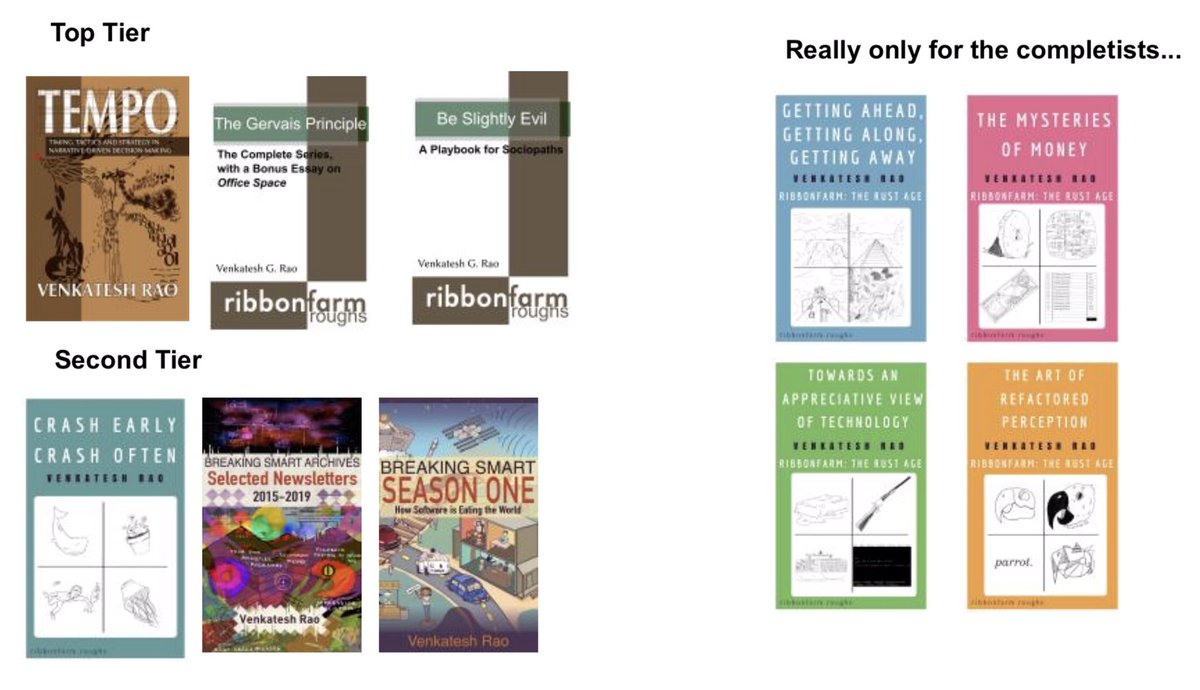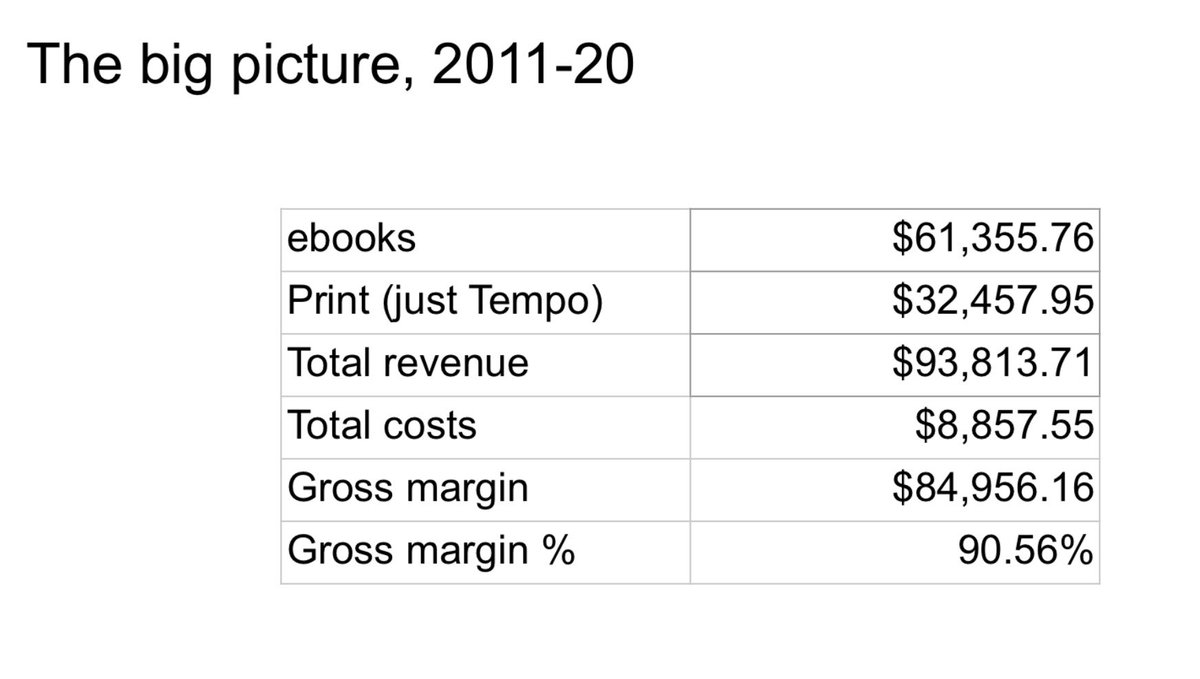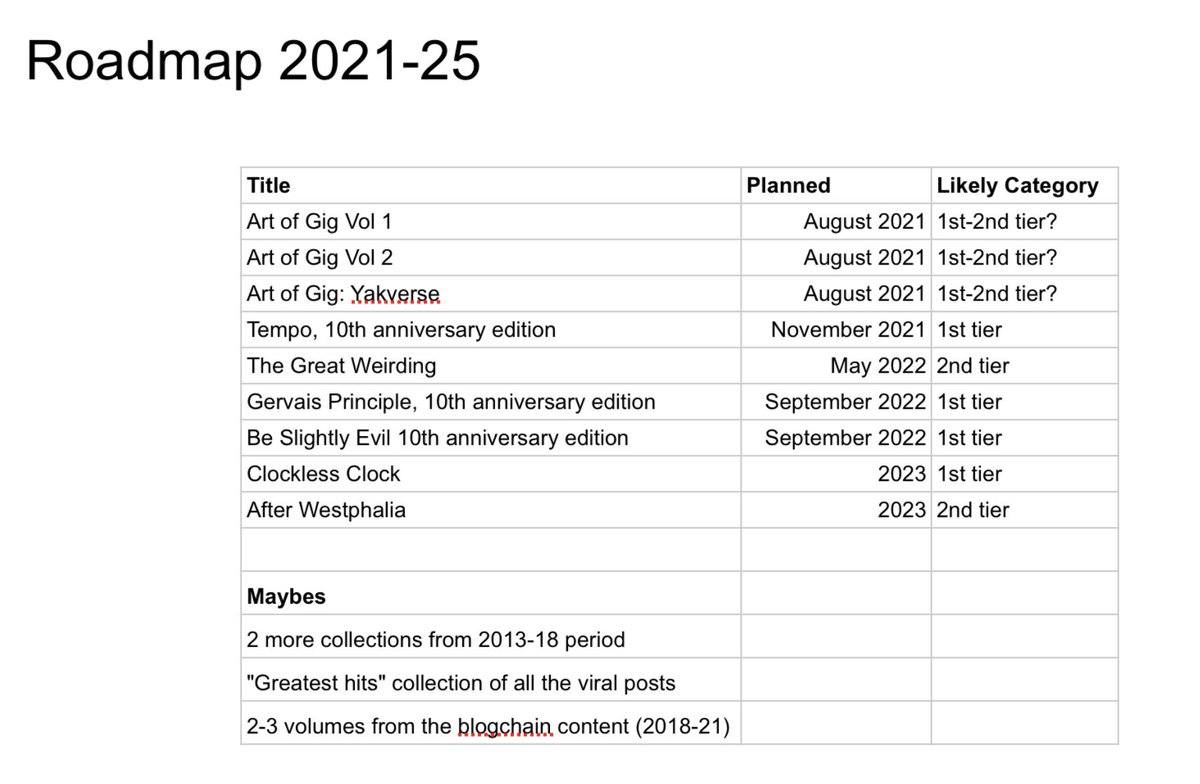Just did an analysis of 10 years of half-assed self-publishing. Executive summary:
Life in the long tail
10 years (started with Tempo paperback in May 2011)
10 volumes — 9 ebook-only, 1 e+p book
~84k at ~90% gross margins
~16.5k ebooks (2/3 of rev) , ~2.8k p books (1/3)
7/10 books in the black, 3 still in red
Takes a couple of years for a book to recover costs
10 years (started with Tempo paperback in May 2011)
10 volumes — 9 ebook-only, 1 e+p book
~84k at ~90% gross margins
~16.5k ebooks (2/3 of rev) , ~2.8k p books (1/3)
7/10 books in the black, 3 still in red
Takes a couple of years for a book to recover costs
The books range from ~$150/mo for the 3 steady bestsellers to ~$75 for tier 2 to $15/mo for tier 3 (can’t compare total revenue meaningfully, since they range from 1 year to 10 years out)
Nice bit of pocket change of ~9k/y averaged over the decade, but obviously a true side hustle. Interestingly it’s about what I made in my first year of grad school as a TA. Not something to live off of, in case any of your are eyeing this business model, but trivial either.
Was doing this analysis to see how good the bones of this LoB are. Clearly enough margin headroom to spend more on production, do print versions of everything. I could have 2xed production budget, added as much again in marketing, and still been profitable with no extra sales.
Considering stepping on the gas a bit for both back-catalog and new productions. There’s quite but on the roadmap for the ribbonfarm blogamatic universe. I’ve just never had the energy to push much harder than this half-assery.
What would Kevin Feige do? https://abs.twimg.com/emoji/v2/... draggable="false" alt="🤔" title="Denkendes Gesicht" aria-label="Emoji: Denkendes Gesicht">
https://abs.twimg.com/emoji/v2/... draggable="false" alt="🤔" title="Denkendes Gesicht" aria-label="Emoji: Denkendes Gesicht">
What would Kevin Feige do?
This is the result of bare-minimum effort, and no marketing beyond posts on my blog/newsletter. I suspect I could have done 2x-3x better at least, but there was always some higher return consulting hustle going.
A lot of my consulting over this same decade has been in the semiconductor industry, so I’ve subconsciously started thinking of this stuff in terms of tape-outs, architecture generations, process shrinks, etc.  https://abs.twimg.com/emoji/v2/... draggable="false" alt="😆" title="Lächelndes Gesicht mit geöffnetem Mund und fest verschlossenen Augen" aria-label="Emoji: Lächelndes Gesicht mit geöffnetem Mund und fest verschlossenen Augen">
https://abs.twimg.com/emoji/v2/... draggable="false" alt="😆" title="Lächelndes Gesicht mit geöffnetem Mund und fest verschlossenen Augen" aria-label="Emoji: Lächelndes Gesicht mit geöffnetem Mund und fest verschlossenen Augen">
Currently on the 14nm ebook process.
Currently on the 14nm ebook process.
Also lol @ 1000 true fans theory. That’s not how this shit works. At all. The only way to make enough money at this for it to be the highest return activity in your hustling portfolio is to shill and grind so hard you have no choice but to be in lolcow territory.
This catalog would *not* be profitable for a traditional publishing cost structure. Assuming average 10k advance/book, the top line would have had to be ~1m for a publisher to make back their investment and start paying out net royalties to me. I’d have made roughly the same.
I’ve had 2 publishers and 1 agent reach out to me over the years. None of those conversations went anywhere (first 2 lost their job, third kinda got canceled). But even if they had, this would likely not have been a good bet for them even if I’d persuaded them to make it.
The thing is, there’s an uncanny valley here. Between the most effort/investment it’s worth it for an indie self-publisher to put in and the *least* effort/investment it’s worth it for a regular publisher who has to pay like 6-10 more people in the production chain.
That gap is a function of technology and (currently) non-automatable labor. Layout, copyediting, proofreading, indexing, cover design, quality artwork that renders well in print and on e-ink screens, marketing collateral, advertising, publicist, agents cut...
I studied the cost structure of this stuff quite a bit while I was at Xerox a decade ago. It’s gotten slowly better and the uncanny valley has slowly narrowed. But books are still not a no-brainer money maker for the long-tail indie publisher.
You have to have at least my level of reach (it’s the bare minimum) and understand the unit economics at least as well as I did in 2011 to make it work. This 84k may not seem like much, but it could easily have been much less, for way more futile effort.
By contrast, Substack *is* a no-brainer. Other things bring equal, you can make 10x more per written word with barely any thought or marginal effort.
I freely admit I do books primarily as an identity/ego thing so I have a sense of a record of the shitposting adding up to something.  https://abs.twimg.com/emoji/v2/... draggable="false" alt="🤣" title="Lachend auf dem Boden rollen" aria-label="Emoji: Lachend auf dem Boden rollen">
https://abs.twimg.com/emoji/v2/... draggable="false" alt="🤣" title="Lachend auf dem Boden rollen" aria-label="Emoji: Lachend auf dem Boden rollen">
But it is *very* important for me that the books make decent money and make business sense, so I can feel like it’s not vanity publishing.
But it is *very* important for me that the books make decent money and make business sense, so I can feel like it’s not vanity publishing.
This is also why I’m reluctant to pursue traditional publishing or crossover mainstream success. Either I’d have to con a publisher into making a losing bet or change what/how I write so it is a better mainstream bet. But at indie scale, I can be profitable without doing either.
Weirdly I am vain enough I don’t want biz partners to lose money betting on me, but not care because J. K. Rowling is subsidizing the rest of their catalog. That’s basically taking $ indirectly from Harry Potter fans while my own remaindered copies get recycled into toilet paper.
I hope I’m not dissuading others from getting into writing (it can’t be called a career for most who do it). You should do it, and even do it for the money, but don’t lie to yourself about how the money works. Scoring a big advance while the publisher loses money is not a win.
Shoot for the right thing — your words should make money for every person who touches them on the way to the market, and kill the fewest trees (and ideally no unread dead trees) on the way to being read by the most people who actually want to read them, and won’t regret buying.
I prioritize ebooks primarily for production ease, but also for environmental reasons.
In general, regret minimization is a good frame. Minimize the number of people who might regret buying (especially if a tree must due for them to try your book).
In general, regret minimization is a good frame. Minimize the number of people who might regret buying (especially if a tree must due for them to try your book).
This is the first time I’ve actually run the numbers and realized how conservative on costs I’ve been with this much margin room. My sense is, gross margins in books should be ~50% not 90%. I ran this way too lean. I should have spent perhaps 30k on production/marketing.
But then again, this thread is 100% hindsight. In the moment, I had no idea how well or poorly the books would do. It wasn’t obvious that this could absorb more capital for more return. And cash flow from consulting wasn’t reliable enough to blow on potentially vanity publishing.
Btw the numbers I’ve shared are net of distribution and printing. I make 70% of cover price on ebooks and 75% in print. I’ve done almost no price optimization. Mostly just kept things as cheap as possible for maximal affordability.
As far as I can tell, my books behave normally on the supply-demand front. Price goes up, unit sales go down. These ain’t Veblen goods.
I find it most comfortable to treat book publishing like stock market investing not work. I price the labor of writing itself at zero since I do it for fun anyway and it mostly pays off in other ways. So the ROI is lifetime return on initial marginal production investment.
The dollar outlay was about 8.8k but my own production labor was probably ~10k if I did it for someone else. So basically around a 5x return. Several of my stocks have done better. Financially it would have been better to invest the money in $amzn or $tsla and less labor  https://abs.twimg.com/emoji/v2/... draggable="false" alt="🤣" title="Lachend auf dem Boden rollen" aria-label="Emoji: Lachend auf dem Boden rollen">
https://abs.twimg.com/emoji/v2/... draggable="false" alt="🤣" title="Lachend auf dem Boden rollen" aria-label="Emoji: Lachend auf dem Boden rollen">
That’s a slightly depressing thought. Investing in publishing my own work easily beat the S&P but not my best investments.
Here’s a page of my book links (plus books by other contributors to my blog). My personal favorites from my own catalog are Tempo and Crash Early, Crash Often  https://abs.twimg.com/emoji/v2/... draggable="false" alt="😎" title="Lächelndes Gesicht mit Sonnenbrille" aria-label="Emoji: Lächelndes Gesicht mit Sonnenbrille"> https://www.ribbonfarm.com/our-books/ ">https://www.ribbonfarm.com/our-books...
https://abs.twimg.com/emoji/v2/... draggable="false" alt="😎" title="Lächelndes Gesicht mit Sonnenbrille" aria-label="Emoji: Lächelndes Gesicht mit Sonnenbrille"> https://www.ribbonfarm.com/our-books/ ">https://www.ribbonfarm.com/our-books...

 Read on Twitter
Read on Twitter

 " title="Considering stepping on the gas a bit for both back-catalog and new productions. There’s quite but on the roadmap for the ribbonfarm blogamatic universe. I’ve just never had the energy to push much harder than this half-assery.What would Kevin Feige do? https://abs.twimg.com/emoji/v2/... draggable="false" alt="🤔" title="Denkendes Gesicht" aria-label="Emoji: Denkendes Gesicht">" class="img-responsive" style="max-width:100%;"/>
" title="Considering stepping on the gas a bit for both back-catalog and new productions. There’s quite but on the roadmap for the ribbonfarm blogamatic universe. I’ve just never had the energy to push much harder than this half-assery.What would Kevin Feige do? https://abs.twimg.com/emoji/v2/... draggable="false" alt="🤔" title="Denkendes Gesicht" aria-label="Emoji: Denkendes Gesicht">" class="img-responsive" style="max-width:100%;"/>


